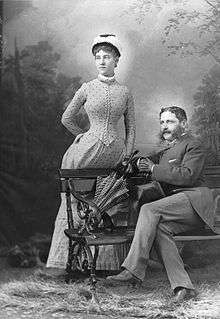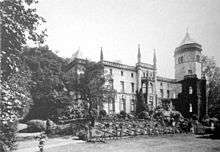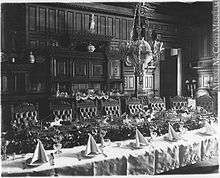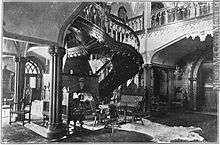Alfred Baumgarten
| Baron Alfred Baumgarten | |
|---|---|
 | |
| Born |
13 November 1842 Dresden, Germany |
| Died |
3 October 1919 (aged 76) Montreal |
Baron Alfred Moritz Friedrich Baumgarten Ph.D. (13 November 1842 – 3 October 1919) was co-founder and president of the St. Lawrence Sugar Refinery at Montreal; life governor of the Montreal General Hospital and Master of Foxhounds for the Montreal Hunt. His home in Montreal's Golden Square Mile is today home to the McGill Faculty Club.[1]
Germany
Born November 13, 1842, at Dresden. He was the son of Dr Moritz Friedrich Oswald Baumgarten (1813-1849), court physician to King Johann of Saxony, and Emmy Zocher, lady-in-waiting to Queen Carola of Saxony.[2] His mother was a daughter of Gustav Zocher, an early friend of the composer Richard Wagner.[3] Alfred was an elder brother of Paul Clemens von Baumgarten. Educated in Dresden, he studied chemistry at the University of Berlin and the University of Göttingen which included two years practical experience in the chemical works at Schöningen. In 1864 he was awarded a doctor of philosophy for his dissertation on the occurrence of vanadium in the mother lyes of soda manufacturing. He became manager of a sugar beet house at Hamersleben, remaining there until 1866 when business opportunities surrounding the rapid development of the new world attracted him.[4]
New York






Baumgarten came to New York City in 1866, with the intention of entering business life in connection with North American chemical works. He was for a time assistant in the laboratory of Professor Charles F. Chandler of the New York School of Mines. There he formed a partnership with C.W. Walter and established the Laurel Hill Chemical Works under the firm name of Walter & Baumgarten. The company later came to be known as the Nicholson Company, the largest acid works on the American continent. Baumgarten also held the position of manager of the Long Island Sugar refinery in New York.[4]
Montreal
In 1873, Baumgarten came to Montreal as manager of the de Castro Syrup Company. In 1879, he co-founded the St. Lawrence Sugar Refining Company, becoming the company's vice-president and afterwards president following the death of Walter Richard Elmenhorst in 1894. The company imported raw sugar from the British West Indies and Europe before refining it into pure sugar. The enterprise was established on a relatively small scale, but the plant was constantly enlarged to meet the growing demand of the trade. The original buildings in Montreal were destroyed by a fire in 1887, and the new factory was built at Maisonneuve on a site which allowed the largest steamships laden with sugar to deposit their cargo at the factory doors. By 1908, the company was valued at five million dollars and exported 300,000 barrels annually.[4]
In 1911, he was appointed a director of the Bank of Montreal. He was a director of C. Meredith & Company; vice-president of the Montreal Archaeological Institute and published several essays on chemistry. He retired from business life in 1912 and was succeeded as president of the St. Lawrence Refinery by John Wilson McConnell, though he remained the principal shareholder and was given the position of honorary president. From just May to October, 1913, the St. Lawrence Refinery's estimated profit was $780,249.
Anti-German sentiment in World War I
Leading up to the First World War, anti-German sentiment spread through the British Empire and after the outbreak of war the hysteria reached a peak. The St. Lawrence Sugar Refinery was directly targeted for allegedly still being 'in the hands of the enemy' as many of the principal shareholders were of German origin. By 1915, J. W. McConnell was forced to hold a shareholder's meeting to discuss "the serious menace to the welfare of our business caused by hostile publications in the press against certain persons connected with our company." They were left with little choice - every shareholder with a German-sounding name was bought out. As well as being bought out, Baumgarten was forced to resign all positions connected to the firm as did his brother-in-law, the vice-president and managing director, Otto Wilhelm/William Donner. This caused Baumgarten much sadness, and adding to this sadness, several associates from before the war shunned him personally. His close friends stood by him and were equally frustrated by his unjust treatment.[5] At his death in 1919, Sir George Drummond affirmed the standing of his friend as "a man of excellence in every particular."[2]
Family and Private Life
In 1885, Baumgarten married Martha Christina Donner (1866-1953), one of the two children of Jean/John Donner (1841-1899), of Altona, Hamburg and Agnes P. Griebe. A descendant of Corad Hinrich Donner of Donners Park, Altona, Martha's father came to New York City and co-founded the de Castro & Donner Sugar Refinery. He was superintendent of the American Sugar Refining Company and manager of the Sugar Trust at New York. Donner shared with his son-in-law a love of horses and was a prominent member of the Jockey Club, though he never allowed any of his horses to be entered into a race under his own name.[6] Martha's only brother, Otto Donner, married Alice Louise Monk, niece of the Hon. Frederick Debartzch Monk. The Baumgarten's were the parents of two daughters,
- Mimi Donner Baumgarten (b. 1888),
- Elsa Baumgarten (b. 1900), married Reginald Leslie Gault (1881-1943), a first cousin of Brigadier-General the Rt. Hon. Andrew Hamilton Gault, of Montreal, who personally raised Princess Patricia's Canadian Light Infantry.[7] They were the parents of Osra and Peter Hamilton Gault (1919-1978).
He purchased a country home at Sainte-Agathe-des-Monts in 1895. It eventually had stables and galleries and dominated the hillside overlooking the lake. The house still stands today, at 154 chemin Tour du Lac. His large stables still exist today too, having evolved through becoming a recreational centre with an indoor skating rink with apartments. The balance of the land north of the road became the Manor House, now La Calèche, and the fields became a ski-hill.
Baumgarten was a member of the Jockey, Forest and Stream, Mount Royal and St. James Clubs at Montreal. He was life governor of the Montreal General Hospital, the Montreal Western Hospital and the Alexandra Hospital. He had enjoyed a prominent place in Montreal's social world, but when the First World War broke out in 1914, he was shunned by many of his old associates because of his German origins; aspersions were cast that he was a sympathiser. At his country home, stories were told that the house was used by the spy Joachim von Ribbentrop. His close friends stuck by him, but he retired from public life and spent the greater part of his time at his country house.[2] He died in 1919, leaving provision for his family and generous donations to the three hospitals he served as governor.
Montreal Hunt
Baumgarten was an ardent sportsman and had a passion for horses. From 1882 to 1887, Baumgarten was Master of Foxhounds for the Montreal Hunt, rejuvenating the club after the departure of British troops from Canada in 1870. He introduced dinners and dancing after the meet and in 1881 bought a parcel of land on the corner of what is today Mount Royal Avenue and Delormier Avenue.
At his own expense, on the land he built new kennels and a clubhouse that included a banquet room, a billiards room, a ballroom, a swimming pool and a library.[5] The front of the clubhouse featured a long gallery described as a piazza where ladies and friends might view the meet. The interior was decorated in light oak with burnished brass. The fireplace in the entrance hall was decorated with Dutch tiles depicting hunting scenes. The swimming pool was described as "an oriental plunge bathroom all inlaid with white tiles."[8]
Baumgarten House, Montreal
In 1880, Baumgarten purchased land on McTavish Street within Montreal's Golden Square Mile. Three of the eight houses of Rupert's Terrace were demolished to make room for the Baumgarten house, which was completed in 1887.
The house had a modest exterior, but the interior was sumptuously decorated and boasted a 'sunken bathtub' (an indoor swimming pool), the first in the city. It was also the first private residence to be fitted with electrical lighting.[9] In 1902 he made further extensions to his home adding further reception rooms and a ballroom built for his two daughters who had just come of age.
The ceiling of the ballroom, from which hung several chandeliers, was supported by marble columns and a minstrels' gallery was suspended from the ceiling with brass cords. The ballroom floor was built on springs to help boost the dancers' feet. Baumgarten personally designed and built the spring floor in 1882 for the Montreal Hunt clubhouse and it was transplanted to his home when the Hunt moved to a new home.
The Gothic Gallery, which spanned two stories of the house, was made to resemble a German hunting lodge and was covered by an immense, amber-coloured stained glass skylight.[10] In the early 1900s his home was the favourite Montreal place for Governor-General the Earl of Minto.[1]
Shortly after the outbreak of the First World War, Baumgarten offered his Montreal residence to be used as a convalescent home for disabled soldiers returning from the Front, and donated liberally towards this cause.[2]
After Baumgarten's death in 1919, the house continued to be lived in by his widow and their two daughters. In 1926, McGill University purchased the house for a nominal sum to serve as a residence for the principal of McGill. General Sir Arthur Currie occupied the house until 1935, but it was felt by his successor that the house was too grand for his needs and from 1935 the house was renovated to become the McGill Faculty Club. At this time, the Gothic Gallery was split into two separate floors, the lower of which is now the main dining room, and the upper of which serves as the billiard room.[10]
References
- 1 2 Allen, Elizabeth. "The Home the Kaiser Never Visited". McGill Faculty Club. Retrieved 28 Nov 2011.
- 1 2 3 4 Wood, William (1931). The Storied Province of Quebec: Past and Present. Toronto: Dominion Publishing Company.
- ↑ Newman, Ernest (1938). The Life Of Richard Wagner, Volume 1: 1813-1848. NY: Knopf.
- 1 2 3 Sulte, Benjamin (1908). A History of Quebec, Its Resources and People. Montreal: Canada History Company.
- 1 2 Fong, William (2008). J.W. McConnell: Financier, Philanthropist, Patriot. Montréal: McGill-Queen's University Press. ISBN 9780773532700.
- ↑ Sugar Trust Manager Dead, 1899
- ↑ Fintra House, Donegal
- ↑ "Apex of Montreal Society met at Hunt Club". Montreal Gazette. 30 June 1984.
- ↑ "The Faculty Club: A well-carved niche". McGill Faculty Club. 2010.
- 1 2 "Baron Alfred Baumgarten and the Home he Built". McGill Faculty Club and Conference Centre. Retrieved 30 Aug 2013.